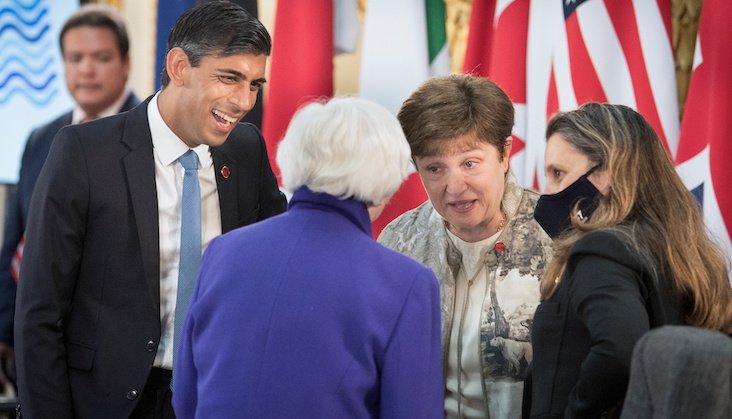The IMF managing director Kristalina Georgieva described it as ‘a shot in the arm for the global economy at a time of financial crisis’ and that it should it ‘should particularly help vulnerable countries struggling to cope with the impact of Covid 19’.
So far, so good. Georgieva and her colleagues at the IMF have done the heavy lifting. They have persuaded the richest economies and the biggest shareholders of the IMF to suspend their uber nationalism and contribute to a common project: a lifeboat for the international economy.
Never mind that it is in their self-interest to back the $650bn free money plan, most western treasuries have resident curmudgeons eagerly searching for reasons to block payments for anything resembling a public good, worse still a ‘foreign’ public good.
Last year the curmudgeons rallied around Donald Trump’s gold -plated flagpole seeing off any bid for rational international cooperation. They were enthusiastically abetted by Saudi Arabia’s problematic leadership of the G20 (the world’s 20 biggest economies) which saw the organisation at its weakest for a decade.
The best the world’s richest could manage as the pandemic tore through developing economies was an offer to suspend interest payments, for just six months, for heavily indebted countries. And they timidly suggested that commercial creditors should follow suit. They did not, instead suggesting that countries taking up the G20 offer would see a hit to their credit ratings.
There was no serious effort to address the global inequities in public health and vaccine distribution, much less to tackle the systemic financial crises faced by many economies in Africa, Asia and Latin America.
Under President Jo Biden and Treasury Secretary Janet Yellen that mood has changed. Up to a point. Much of the international machinery is still in retreat; the rest is decidedly creaky.
Biden and Yellen gave a green light to the IMF’s $650bn bonanza but they stopped there.
Now the bigger questions are political: who gets the money and what should they do with it? To those that have, more shall be given has been the abiding rule in the international system.
High-income countries, because of the size of their IMF shareholdings, will get 58% of the $650bn of the free money: the Group of Seven richest countries get 44%; China gets 6%. Some 70 low-income countries with a total population of 1.2 billion will get just 3.2%.
That does not have to be set in stone.
The high-income countries could reallocate their share of the SDR reserves, which they do not need, to those countries whose economies have been strafed by the pandemic. Over 55% of low-income countries are already in debt-distress or getting into that territory.
The IMF has explained how the pandemic could inflict long-term wounds to those countries’ development prospects. To avert this, says the Fund, these countries would have raise some $500 bn over the next three years.
That would include some $200bn on public health spending to contain, then end the pandemic; and another $250-350bn of investment in power, transport, digital and green technology. This is not fantasy accounting: the money will be sitting in the central banks of the world’s richest economies by the end of this month.
Much of this windfall for the richest could be transferred to the hardest-hit countries via a bundle of debt relief, low-interest loans and grants. It would not be starry-eyed philanthropy but a constructive bid to reboot the global economy. Rich economies would be the main beneficiaries from the boost to global trade and allied tax revenues.
Such a transfer of official funds would trigger local and international commercial investment in the hardest-hit countries, opening the prospects for economic transformation.
Most of these ideas have been zinging through the in-boxes of the G20 economic advisors, while their bosses, now chaired by Italy, nod sagely about the need for action, but procrastinate.
In June, the G7 agreed a plan to transfer $100bn of the SDR windfall to the hardest-hit countries. Weeks later, the G20 failed to agree on how that would work. Now the people of Africa, Asia and Latin America, the vast majority of whom lack vaccines, face another wave of the pandemic and sundry variants of the virus.
This debate about how to use the IMF’s SDR money mountain will not go away. Nor should it, until we can agree on a way to save millions of lives and boost the economic prospects of hundreds of millions more.
One project of dazzling clarity and flawless logic is ready to launch in the meantime. It is the fully-costed $50bn plan to vaccinate 40% of the people in all countries by the end of this year, and at least 60% by July 2022. The figures are crunched by the IMF’s Chief Economist Gita Gopinath and her colleague Ruchir Agarwal.
Gopinath’s and Agarwal’s plan, fully endorsed by IMF chief Georgieva, is the best chance to contain the pandemic and to re-energise the international economy. The project would generate $9 trillion in cumulative economic benefits by the end of 2025, they estimate.
As Georgieva points out, that is an investment-to-return ratio of 180 to one. Even fortified by Bolivian marching powder, financial traders dare not dream of such profits.
So here is a modest proposal.
The governments of Africa, Asia and Latin America, through their collective organisations, should call for the UN to convene a summit immediately to agree how $50bn of the $650bn SDR windfall can be allocated to fund this global vaccine project.
It should not require feats of rhetoric to persuade the bean counters of the G20 to see the benefits to their treasuries. For the rest of the international system, it would be pushing at an open door. Already, the World Health Organization, the World Trade Organization and the World Bank have backed it in principle.
The point is now to back it in practice.
